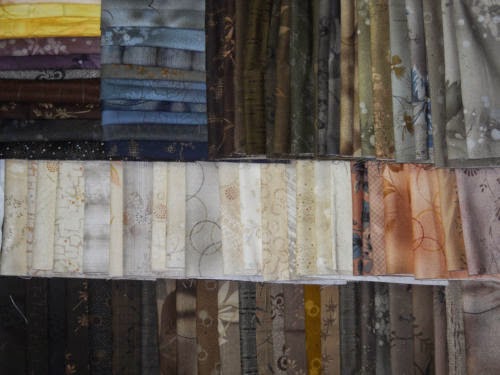 |
| A block for my grandmother's log cabin quilt |
 |
| Construction Diagram by Janet Wickell |
When I plan a quilt with a specific person in mind, one of the first things I think about is that person's style and their personal color scheme. When I picture my grandmother's home, the main colors I see are brown. My grandmother is an extraordinarily practical person. Her cupboards and lightswitches have labels. Her couches are protected with towels. Things have specialized containers and assigned places. Brown furniture, walls, and carpeting are practical, because when brown gets dirt on it, you can't see the dirt (my grandmother would still make sure there was no dirt, but just in case, brown). Brown indoor-outdoor carpeting is even more practical, because it won't mind getting wet when a hurricane decides to flood your house.
In my youth, I was skeptical that brown could be a favorite color, because it was the color of dirt. But I knew people who claimed it as theirs, so I had to stretch my imagination and believe that it could indeed be someone's very favorite. As I grew older I came to love brown as a color of soil, bark, nutmeg, coffee, my brother's eyes. Psychologist Carole Kanchier says that brown projects honesty, stability, practicality, and commitment. It has seriousness and depth. I sometimes wear brown when I want to feel grounded. It connects me to the earth.
Something else I've learned about brown while trying to sort my fabric scraps: browns participate in many other colors. Browns can be red, blue, yellow, green, purple... Learning to perceive their variety and subtleties can turn a previously muddy picture into a visually rich exploration of colors' hidden possibilities and interactions.
I recently came across a beautiful lot of Japanese taupe fabrics on ebay. The description of this lot indicated that the seller had collected these fabrics. I had not known that this was a category one could collect, but it piqued my curiosity, so I began to research its history and use.
 |
| Japanese taupe fabrics from the Centenary Collections by Yoko Saito for Lecien Fabrics and Daiwabo by E. E. Schenck Co. |
Although my palette veered more toward the brown side of taupe, I took this advice to heart in selecting fabrics for my grandmother's quilt. In the spirit of late nineteenth century log cabin quilts, I decided to use fabrics that incorporated a rich variety of textures and fiber content as well. To achieve this, I used decorator samples from swatch books by Kravet, JAB, Highland Court, Lee Jofa, Andrew Martin, and others. These are all high-end fabric designers, adding a touch of bargain luxury that I thought my very frugal grandmother definitely deserved. The fabrics included silk, chenille, damask, linen, velvet, jacquard, cottons, and luxury blends. These fabrics are not all easy to work with, and they produced a mess of fibers that gave me sinus headaches and sent our vacuum cleaner to the vacuum cleaner hospital. It was worth it.
 |
| My grandmother's log cabin quilt top |
In keeping with the traditional light and dark color scheme, I used whites and off-whites for my light fabrics, and browns and taupes for my dark fabrics. A few fabrics, dark beiges or light tans, could have worked in either category. When I used them I worked to ensure that there was adequate contrast within the block to keep the color scheme intact.
My center squares were 1 1/2" cut or 1" finished, and each log was similarly cut at 1 1/2" wide for a finished width of 1". I designed the blocks with seven logs on each side - this creates a larger block and yields a fairly simple overall design that is more static than I might have chosen for myself, but it has a certain tidiness and precision that I think suits my grandmother perfectly. I chose to have six white diamonds framing two brown diamonds to represent her family: two parents in the middle, surrounded by their six children, my mother, aunts, and uncles. It reminds me of the portrait wall in my grandmother's house in North Carolina, which featured a beautiful framed portrait of each of them in their youth.
The thickness of the fabrics used in the quilt top will make this a bit of a bear to quilt on my home machine, so I expect to keep the quilting fairly simple. I will share pictures when it is done.
Quilts are often handed down from generations. I like the idea of handing this one up. I'd love to hear your own stories of quilting for parents and grandparents.
























.jpg)












